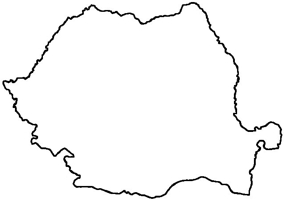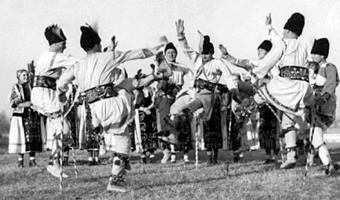
|
The Society of Folk Dance Historians (SFDH)
Romania's Călușarii
[
Home |
About |
Encyclopedia | CLICK AN IMAGE TO ENLARGE |

|
 The 50th day after Orthodox Easter marks the beginning of the fearsome five days when the dead rise to cast evil, sickness, and bad luck about the countryside. It's Whitsuntide or Pentecost or — in Romania — "rusalii." In a world guided by superstition, the people turn to rituals older than memory to protect themselves from these evil forces and ensure fertility, long life, and good luck.
The 50th day after Orthodox Easter marks the beginning of the fearsome five days when the dead rise to cast evil, sickness, and bad luck about the countryside. It's Whitsuntide or Pentecost or — in Romania — "rusalii." In a world guided by superstition, the people turn to rituals older than memory to protect themselves from these evil forces and ensure fertility, long life, and good luck.
Early on the morning of that day, the women of the village rise before dawn and move silently in the early morning chill to the cemetery where they will honor the deceased members of their "neam," or extended family. Candles are placed on the graves to provide light to the deceased, since their needs are considered to be the same as the living. It is a time of deep mourning for those on the other side of the same universe. And it is a plea for benevolence from the deceased spirit.
The evening before, a group of men from the village, dressed in white trousers and long white shirts, had gathered at a secret ceremonial site to become "călușarii" — the major force of protection from the impending danger. They are led by a "vataf" with absolute, unquestioned authority over the group. A "steag" ("flag") is constructed to lead them on their coming ritual and represent their power. Garlic and wormwood are wrapped on the end of a 10-foot pole with a white cloth. On a shorter pole, a rabbit skin is stretched over a wood frame — the "cioc" — for the vataf to carry as a symbol of his power and authority.
An oath is taken to abide by the groups' laws and traditions, to obey the vataf, share in the gifts to come, abstain from sex and, above all, keep the group's secrets — under a promise of vile sexual defilement of an offending călușarii's family. This is serious business. During rusalii they will replace the sorcerer as healer and protector of the village. Once through the cycle of the căluș and the "legares călușarii" is completed.
 The călușarii are now supernatural beings, removed from their normal lives as farmers or tradesmen. Their task is to bring their magic to the village, healing the sick, bringing luck and health to the young, protection from evil, fertility to parents and crops alike. Their white costume, festooned with bells around the knees and woven strips of fabric crossing over the shoulders and carrying a stick about one meter in length, they begin their visit to the villagers' homes.
The călușarii are now supernatural beings, removed from their normal lives as farmers or tradesmen. Their task is to bring their magic to the village, healing the sick, bringing luck and health to the young, protection from evil, fertility to parents and crops alike. Their white costume, festooned with bells around the knees and woven strips of fabric crossing over the shoulders and carrying a stick about one meter in length, they begin their visit to the villagers' homes.
The mute accompanies the group, a masked creature who carries a wooden sword and acts as the clown. He represents death and resurrection and being hit with his wooden sword is good luck. Many villagers attempt to touch the mute as he passes by. He partakes in the ritual by scribing a sacred dance circle in the yard of the homes, wherein the călușarii will perform their magical dance.
As the group reaches each house, the vataf knocks on the door and asks permission to dance. Of course! The călușarii are welcomed with open arms. To do otherwise could result in illness and even death. The steag is posted in the center of the circle with a bowl of water and a plate containing stalks of grain, garlic, salt and wormwood, provided by the home owner. Preparations completed, the călușarii begin their dance, accompanied by uncostumed musicians.
And what a dance it is — the Căluș. Beginning with a slow strutting walk around the circle, the dance slowly quickens into a frenzy of brilliant footwork, accompanied by shouts and calls, ringing bells, and magnificent music driving them on. Great agility and stamina is required for the squats, leaps, and athletic movement of the dance. To the călușarii, the dance is the medium for delivering their magic.
As the călușarii make their rounds, it is possible that two groups may meet. When they do, excitement runs high. In former years, a fight could ensue, sometimes to the death. In more civilized times, a dance competition replaces the brawl. One can only imagine the theater of it all, much to the villagers' delight. If time and distance permit, the călușarii will visit other nearby villages, spreading both their magic and rewards.
Mothers bring their children for the călușarii's attentions. If the child is healthy, the călușarii may hold the child while dancing, ensuring long life and good health. If the child is ill, the călușarii will leap over the prostrate child three times in the traditional healing ritual. On occasion, women and unmarried girls may dance with the călușarii, thus ensuring health, fertility, and attraction of a suitable husband. The călușarii are indeed very powerful forces.
On the second Tuesday after rusalii begins, the group meets at the vataf's home to share the gifts and to conduct the "dejgares călușarii," the ritual returning them to the status of villagers. The "steag" and "cioc" are ceremoniously dismantled, each man taking a part of it for himself. Then the pole is held horizontally and dropped. The men flee in all directions, then return and greet each other as though away for a long time. The pole is then buried in a secret place and the rusalii has been laid safe for another year.
Though modern forces have diluted the călușarii ritual, the Căluș is in the repertoire of most of Romania's professional dance companies and has been performed in dance concerts around the world. None who see it are unmoved by its power and energy.
The Căluș should not be considered a folk dance, rather a dance of religious ritual. It is not danced by the people, rather by specifically designated individuals who perform it under a specific situation for spiritual reasons. It is related to the Morris Dance of England and to various other rituals throughout Europe where health, fertility, good luck, and sex appeal are encouraged through the dance.
For further readings about the Căluș and călușarii, read "Căluș, Symbolic Transformation in Romanian Ritual" by Gail Kligman, published by University of Chicago Press.
DOCUMENTS
- From the Village to the Stage: Ritual Dance and Dancers, an article.
- Richard Duree, an article.
- Romania, a country.
Used with permission of the author.
This page © 2018 by Ron Houston.
Please do not copy any part of this page without including this copyright notice.
Please do not copy small portions out of context.
Please do not copy large portions without permission from Ron Houston.